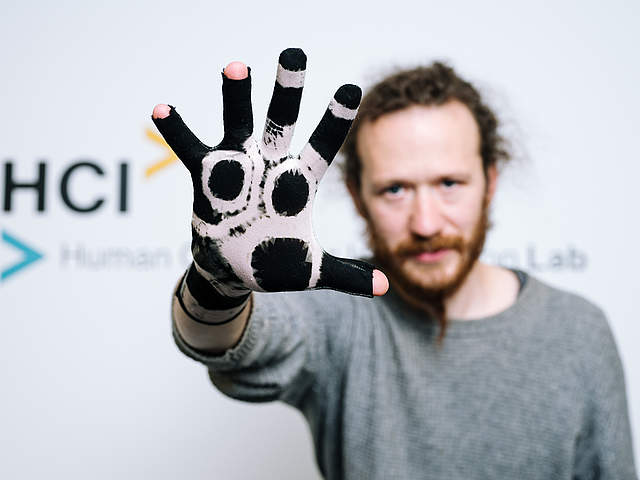 Whether in the fitness sector, in medicine or in the entertainment industry: IT devices worn on the body such as smart watches are becoming increasingly popular. Applications of this kind benefit from the input device adapting to the body as naturally as possible - for example in the form of electro-sensitive fabrics, so-called e-textiles. Computer scientists at Saarland University show how these special textiles can be produced in a comparatively uncomplicated way, opening up new usage scenarios.
Whether in the fitness sector, in medicine or in the entertainment industry: IT devices worn on the body such as smart watches are becoming increasingly popular. Applications of this kind benefit from the input device adapting to the body as naturally as possible - for example in the form of electro-sensitive fabrics, so-called e-textiles. Computer scientists at Saarland University show how these special textiles can be produced in a comparatively uncomplicated way, opening up new usage scenarios.
"Our goal was to integrate interactive functions directly into the fibres of textiles instead of just attaching electronic components to them," says Jürgen Steimle, Professor of Computer Science at Saarland University. With his research group on human-computer interaction at Saarland Informatics Campus, he is investigating how computers and their operation can be integrated as seamlessly as possible into the physical world. This includes the use of electro-interactive materials.
Previous approaches to the production of these textiles are complex and influence the feel of the material. The method of the Saarbrücken computer scientists makes it possible to convert textiles and garments into e-textiles even after they have been made, without affecting their original wearing properties - they remain thin, stretchy and cuddly. In this way, they create the opportunity to experiment with new forms of e-textiles quickly and in many different ways and to integrate them into IT equipment.
"For devices worn on the body in particular, it is important that they restrict movement as little as possible while still being able to process high-resolution input signals," explains Paul Strohmeier, one of the initiators of the project and a scientist in Steimle's research group. To achieve this, the researchers are using the process of in-situ polymerisation. In this process, the electrical properties are "dyed" into the fabric: a textile is subjected to a chemical reaction in a water bath, known as polymerisation, which makes it electrically conductive and sensitive to pressure and stretching, giving it so-called piezoresistive properties. By "dyeing" only certain parts of a textile or polymerising individual threads, the Saarbrücken computer scientists can produce tailor-made e-textiles.
In their test runs, the researchers have thus produced gloves that can digitally record hand movements, a zip fastener that transmits different tensions depending on the degree of opening, and sports tapes that transform into a control element attached to the body.
Materials other than textiles can also be processed with the method. Parisian artist Audrey Briot has created an evening gown made of touch-sensitive feathers that generate sounds via a computer when touched. She polymerised the feathers using the method of the Saarbrücken computer scientists. The dress was nominated for the STARTS Prize of the European Commission.
A scientific publication on the method entitled "PolySense: Augmenting Textiles with Electrical Functionality using In-Situ Polymerization" was produced in the research group on human-computer interaction at the Saarland Informatics Campus at Saarland University. Participating Saar researchers were: Prof. Dr. Jürgen Steimle, Dr. Paul Strohmeier, Dr. Marc Teyssier and Dr. Bruno Fruchard. Also involved were: Prof. Dr. Jürgen Steimle, Dr. Paul Strohmeier: Cedric Honnet (MIT Media Lab), Hannah Perner-Wilson (Kobakant) and Dr. Ana C. Baptista (CENIMAT/I3N, New University of Lisbon). The paper was published in 2020 in the context of the world's largest conference in this field of research, the 'ACM Conference on Computer Human Interaction (CHI)'.


















































































